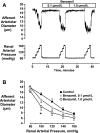Effects of amiloride, benzamil, and alterations in extracellular Na+ on the rat afferent arteriole and its myogenic response
- PMID: 18495800
- PMCID: PMC2494521
- DOI: 10.1152/ajprenal.00200.2007
Effects of amiloride, benzamil, and alterations in extracellular Na+ on the rat afferent arteriole and its myogenic response
Abstract
Recent studies have implicated epithelial Na+ channels (ENaC) in myogenic signaling. The present study was undertaken to determine if ENaC and/or Na+ entry are involved in the myogenic response of the rat afferent arteriole. Myogenic responses were assessed in the in vitro hydronephrotic kidney model. ENaC expression and membrane potential responses were evaluated with afferent arterioles isolated from normal rat kidneys. Our findings do not support a role of ENaC, in that ENaC channel blockers did not reduce myogenic responses and ENaC expression could not be demonstrated in this vessel. Reducing extracellular Na+ concentration ([Na+]o; 100 mmol/l) did not attenuate myogenic responses, and amiloride had no effect on membrane potential. Benzamil, an inhibitor of ENaC that also blocks Na+/Ca2+ exchange (NCX), potentiated myogenic vasoconstriction. Benzamil and low [Na+]o elicited vasoconstriction; however, these responses were attenuated by diltiazem and were associated with significant membrane depolarization, suggesting a contribution of mechanisms other than a reduction in NCX. Na+ repletion induced a vasodilation in pressurized afferent arterioles preequilibrated in low [Na+]o, a hallmark of NCX, and this response was reduced by 10 micromol/l benzamil. The dilation was eliminated, however, by a combination of benzamil plus ouabain, suggesting an involvement of the electrogenic Na+-K+-ATPase. In concert, these findings refute the premise that ENaC plays a significant role in the rat afferent arteriole and instead suggest that reducing [Na+](o) and/or Na+ entry is coupled to membrane depolarization. The mechanisms underlying these unexpected and paradoxical effects of Na+ are not resolved at the present time.
Figures










Similar articles
-
Effect of epithelial sodium channel blockade on the myogenic response of rat juxtamedullary afferent arterioles.Hypertension. 2009 Nov;54(5):1062-9. doi: 10.1161/HYPERTENSIONAHA.109.137992. Epub 2009 Aug 31. Hypertension. 2009. PMID: 19720952 Free PMC article.
-
Tubuloglomerular and connecting tubuloglomerular feedback during inhibition of various Na transporters in the nephron.Am J Physiol Renal Physiol. 2015 May 1;308(9):F1026-31. doi: 10.1152/ajprenal.00605.2014. Epub 2015 Feb 25. Am J Physiol Renal Physiol. 2015. PMID: 25715987 Free PMC article.
-
Juvenile growth reduces the influence of epithelial sodium channels on myogenic tone in skeletal muscle arterioles.Clin Exp Pharmacol Physiol. 2016 Dec;43(12):1199-1207. doi: 10.1111/1440-1681.12664. Clin Exp Pharmacol Physiol. 2016. PMID: 27560463
-
Altered myogenic responsiveness of the renal microvasculature in experimental hypertension.J Hypertens. 1996 Dec;14(12):1387-401. doi: 10.1097/00004872-199612000-00002. J Hypertens. 1996. PMID: 8986920 Review.
-
Role of cytochrome P450 epoxygenase in regulating renal membrane transport and hypertension.Curr Opin Nephrol Hypertens. 2013 Mar;22(2):163-9. doi: 10.1097/MNH.0b013e32835d911e. Curr Opin Nephrol Hypertens. 2013. PMID: 23302865 Free PMC article. Review.
Cited by
-
βENaC is a molecular component of a VSMC mechanotransducer that contributes to renal blood flow regulation, protection from renal injury, and hypertension.Front Physiol. 2012 Aug 28;3:341. doi: 10.3389/fphys.2012.00341. eCollection 2012. Front Physiol. 2012. PMID: 22973231 Free PMC article.
-
Altered whole kidney blood flow autoregulation in a mouse model of reduced beta-ENaC.Am J Physiol Renal Physiol. 2010 Feb;298(2):F285-92. doi: 10.1152/ajprenal.00496.2009. Epub 2009 Nov 4. Am J Physiol Renal Physiol. 2010. PMID: 19889952 Free PMC article.
-
Effect of epithelial sodium channel blockade on the myogenic response of rat juxtamedullary afferent arterioles.Hypertension. 2009 Nov;54(5):1062-9. doi: 10.1161/HYPERTENSIONAHA.109.137992. Epub 2009 Aug 31. Hypertension. 2009. PMID: 19720952 Free PMC article.
-
Afferent Arteriolar Responses to β,γ-methylene ATP and 20-HETE are not Blocked by ENaC Inhibition.Physiol Rep. 2013 Sep 1;1(4):e00082. doi: 10.1002/phy2.82. Physiol Rep. 2013. PMID: 24159379 Free PMC article.
-
How NaCl raises blood pressure: a new paradigm for the pathogenesis of salt-dependent hypertension.Am J Physiol Heart Circ Physiol. 2012 Mar 1;302(5):H1031-49. doi: 10.1152/ajpheart.00899.2011. Epub 2011 Nov 4. Am J Physiol Heart Circ Physiol. 2012. PMID: 22058154 Free PMC article. Review.
References
-
- Bell PD, Mashburn N, Unlap MT. Renal sodium/calcium exchange: a vasodilator that is defective in salt-sensitive hypertension. Acta Physiol Scand 168: 209–214, 2000. - PubMed
-
- Benos DJ, Cunningham S, Baker RR, Beason KB, Smith PR. Molecular characteristics of amiloride-sensitive sodium channels. Rev Physiol Biochem Pharmacol 120: 31–113, 1992. - PubMed
-
- Bertorello AM, Katz AI. Short-term regulation of renal Na+-K+-ATPase activity: physiological relevance and cellular mechanisms. Am J Physiol Renal Fluid Electrolyte Physiol 265: F743–F755, 1993. - PubMed
-
- Chilton L, Loutzenhiser R. Functional evidence for an inward rectifier potassium current in rat renal afferent arterioles. Circ Res 88:152–158, 2001. - PubMed
Publication types
MeSH terms
Substances
LinkOut - more resources
Full Text Sources
Miscellaneous

